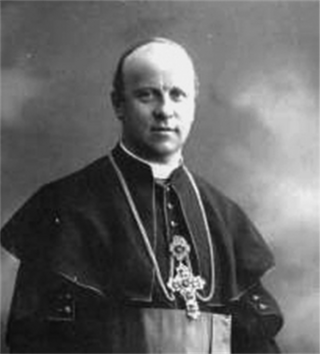Dr. Sigismund Waitz

Personalia
Born:
Died:
Profession:
Persecution:
Victim of arbitrary acts and calls for resistance against "robber state"
Memberships
Curriculum Vitae
Sigismund Waitz was born in Brixen, attended the Brixen grammar school of the Augustinian canons and studied theology in Innsbruck and Brixen after graduating from high school. He was ordained a priest in 1866 and three years later received his doctorate in theology.
After years as a chaplain in Val Pusteria, he became editor of the "Brixener Chronik" and the "Tiroler Volksbote" in 1891, as well as head of the "Landesverband der Barmherzigkeit", the predecessor of Caritas. In 1898, he took over the pastorate in Dietenheim near Bruneck. Prince-Bishop Aichner appointed him Professor of Moral Theology at the Brixen seminary in 1899. Here he developed a zealous activity above all in the social field and politically within the framework of the Christian-social movement, which led to fierce criticism from the conservatives. In 1900 he was the organizer of Brixen's 1000th anniversary celebrations and was active as a councillor for the town of Brixen. In 1904/05, he worked as a religious teacher and tutor to Archduke and later Emperor KarI. In 1913, Sigismund Waitz was appointed Vicar General of Vorarlberg and Auxiliary Bishop in Feldkirch, against the objections of the conservatives. Before this, however, he had to "first dispel the concerns of the Viennese nuncio Emidio Taliani [1838-1907] about his progressive attitude in a personal conversation."
After the First World War, Sigismund Waitz fought for the unity of Tyrol and especially for his home diocese of Brixen, which also extended to North Tyrol as far as the Zillertal, East Tyrol and Vorartberg. In 1921, the Holy See carried out the division of the diocese due to the new national borders. In 1925, this division was actually carried out when the area that had remained with Austria was elevated to the independent Apostolic Administration of Innsbruck-Feldkirch and the former Auxiliary Bishop Sigismund Waitz was appointed as the first administrator. He carried out these duties until 1938, even when he was appointed Prince Archbishop of Salzburg in 1934.
The student association Vindelicia awarded him honorary membership in 1923 and the student association Austria Innsbruck awarded him honorary membership in 1924. He had family ties to Hall in Tyrol because his brother, Dr. Ernst Waitz, had settled here as a saltworks doctor. His two sons Walter and Franz Josef - the bishop's nephews - also suffered under the Nazis. In 1935, he was awarded honorary membership by the student association Austria-Salzburg.
Since Adolf Hitler came to power in Germany, Bishop Sigismund Waitz repeatedly spoke out against National Socialism in newspaper articles. After collaborating on the Concordat of June 5, 1933 between the Holy See and Austria, he was elected Prince Archbishop of Salzburg in 1934 and appointed by Pius XI [1922-39] for the first time under the new electoral provisions of the Concordat. He made particular efforts to promote the Catholic University of Salzburg project, which was decided in 1934 but could no longer be realized after the Anschluss. As Primate, he - together with Theodor Cardinal Innitzer - bears particular responsibility in the negotiations with Gauleiter Joseph Bürckel, "Reichskommissar für die Wiedervereinigung" (Reich Commissioner for Reunification), on the "Feierliche Erklärung der Österreichischen Bischöfe zur Volksabstimmung" (Solemn Declaration of the Austrian Bishops on the Referendum) of 10 April 1938. April 1938, in which the Austrian bishops declared their support for the Greater German Reich. He confides his struggle to find a way out of this muddled political situation in order to protect the Church in Austria in his diary.
"We bishops are aware of the great responsibility we have before the world public ... and even more of the responsibility we have before God ... to help bring about a settlement that guarantees the welfare of the new state without prejudice to the rights of God and the rights of the Church."
After the occupation of Austria, Sigismund Waitz became the victim of various serious arbitrary acts by the Nazi rulers: The windows of his palace in Salzburg were smashed on March 12, 1938, followed by searches of his offices, he himself was subsequently placed under house arrest for several days; his car was searched on the way to Vienna and he was strip-searched.
After the failure of the negotiations on "cultural peace" between the Catholic Church and National Socialism from July to September 1938, in which Sigismund Waitz played a key role, the church struggle began - especially after the inflammatory speech by Gauleiter Bürckel on October 13, 1938. Sigismund Waitz - unbending in his convictions - then called for spiritual resistance against the "robber state" through pastoral words from the pulpit - for example in the sermon on the Feast of Christ the King on October 26, 1941.
Places
Place of activity:
Citations
Fritz, Herbert/Krause, Peter (2013): Farbe tragen, Farbe bekennen 1938–45. Katholisch Korporierte in Widerstand und Verfolgung. (ÖVfStg, 2013) S. 574-576.
